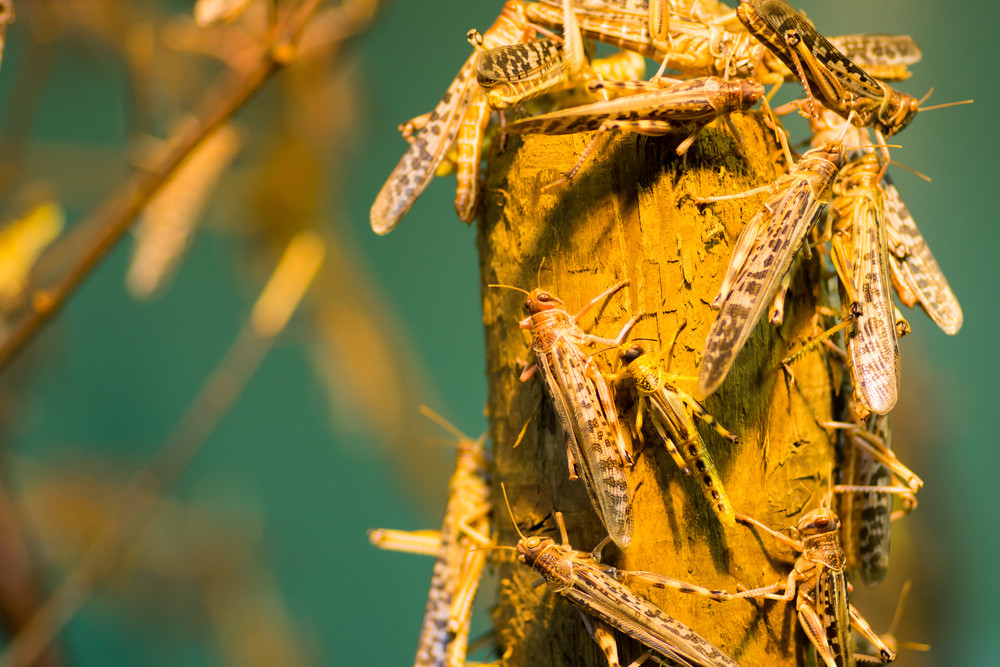Popular Reads
Top Results
Can't find what you're looking for?
View all search resultsPopular Reads
Top Results
Can't find what you're looking for?
View all search resultsPrevention first, before a pest outbreak: Time to adopt agroecological farming
With locust swarms now ravaging crops across Africa, it may be an opportune time for Indonesia to take a closer look at agroecological farming to prevent outbreaks of plant pests and diseases – rather than trying to manage them after the fact.
Change text size
Gift Premium Articles
to Anyone
T
he United Nations Assembly declared 2020 as the International Year of Plant Health (IYPH), dedicated to raising global awareness on preserving plant health and how this can sustain the lives of the billions of people on Earth.
This goal is no exaggeration, considering that crop plants provide the majority of the foods we consume. However, we often neglect the urgency of keeping plants healthy, and unfortunately, this neglect might threaten our future food security.
According to the UN's Food and Agriculture Organization (FAO), approximately 40 percent of global food crops are lost each year to plant pests. This alarming rate of crop loss could lead to global famine, with hundreds of millions of people likely to face starvation. Furthermore, it can significantly impact the crop production sector, which provides the primary source of income for many smallholder farmers in developing countries, including Indonesia.
To make matters worse, the changing climate is not only disrupting crop production around the world, but also creating conditions that are favorable for plant pests and diseases. The FAO has assessed that climate change is "altering the distribution and potential distribution" of pests and diseases.
Amid the challenging impacts of extreme weather on global agriculture, pest outbreaks could deal the final blow to crop production.
While it is difficult to determine the eventual, long-term impact on crop production, the rise in global temperatures and changes in precipitation patterns have clearly contributed to an increase in pest infestations.
The current desert locust outbreak affecting several African countries shows how the changing climate could lead to increased incidence and range of pest invasions.
The unusually heavy rainfall since October 2019 and the cyclones in 2018 that hit several East African countries, including Kenya, Somalia and Ethiopia, spurred locust reproduction and growth. The locust swarms that have emerged since January 2020 are wreaking havoc as they devastate millions of hectares of food crops.
The UN estimates that 20.2 million subsistence farmers across Africa are facing severe food insecurity.
Indonesia is also facing similar problem, although the type of insect pests and the intensity of invasion might be different. From December 2019 to February 2020, the invasion of Spidoptera frugiperda (Gayak caterpillar) has adversely affected 4,585 hectares of the total 12,072 ha of maize grown areas in Flores, East Nusa Tenggara (NTT). The hungry caterpillars can reduce up to 60 percent of crop yields in NTT, as estimated by the Agricultural Technology Assessment Center (BPTP).
East Java has in the past seen swarms of wereng (brown planthopper) devouring hundreds of hectares of paddy fields in Jember and Madiun regency, terrifying farmers with the prospect of massive crop failure. Meanwhile, pengerek batang (rice stem borers) have threatened paddy fields in parts of West Java.
The prolonged drought, followed by a sudden change in humidity from the onset of heavy rainfall, create the perfect environment for the destructive insects to reproduce in larger numbers. Unfortunately, such natural threats to agriculture are unlikely to stop anytime soon as extreme weather continues to strike across the archipelago.
Aside from climate change, the manmade threat of unsustainable farming practices have made our crops more vulnerable to pests and diseases. Our agricultural systems are intended to maximize short-term income while disregarding the consequences in terms of their long-term environmental impacts and resilience against pests and diseases.
For instance, farmers still use high concentrations of chemical pesticides to kill plant pests in their fields. Yet, overusing pesticides can also decimate the pests’ natural enemies – the insects and other organisms that naturally prey on the pests they are trying to eradicate. As a result, the farmers have made their fields more vulnerable in the event of an unusual surge in the population of pest species, as they have killed off the pests' natural predators.
Evidence is also growing that plant pests are developing increased resistance to pesticides. In response, farmers increase their use of pesticides to eventually inflate production costs and increase the amount of chemicals in the air and water to negatively impact on environmental and animal health.
Furthermore, most farmers typically use the monoculture system of cultivating a single crop on a single field at a given time. This can increase the risk and exacerbate the effects of pest outbreaks, as pests that prefer a specific crop, like rice, can easily eat their way from field to field on a farm or in a farming area that cultivates the same crop.
While mitigating the impacts of climate change requires a holistic, unified effort from the public to industry to government, the agriculture industry and individual farmers can still control pests while increasing output and minimizing environmental impact by employing the sustainable approach of agroecology.
Agroecology emphasizes the application of ecological processes to a variety of farming practices, including crop protection and production. At the same time, taking the agroecological approach reduces the negative environmental impacts of agriculture, such as from the use of chemical pesticides.
There is no silver bullet that can stop a pest outbreak, and that is exactly why this approach should be considered. Agroecological pest and disease management relies on preventive rather than reactive measures, and focuses on increasing plant immunity and resistance amid climate change.
In this way, we can establish the adaptive environment of an agroecosystem in which pest populations cannot explode out of control. Instead of using chemical pesticides to temporarily eliminate insect pests, farmers can grow particular tree and flower species near their fields to attract the pests’ natural enemies.
Bunga kenikir or sulfur cosmos (Cosmos sulphureus), for instance, can be planted in the dikes surrounding paddy fields to lure insect predators like ladybugs, bees and dragonflies that feed on rice pests. Farmers can also cultivate indigenous or locally developed crop varieties that are better adapted to the environmental stresses in an area, such as droughts and floods.
Amending soil with organic materials such as compost or crop residue might prevent the eggs or larvae of insect pests from developing to maturity, as healthy soil is rich in beneficial organisms and microorganisms that present natural antagonism toward plant pests and disease.
Farmers can also adopt the polyculture system, also called intercropping, in which two or more different crops are cultivated simultaneously in a single field. This will help reduce the distribution of pests that prefer a single crop. At the same time, farmers will benefit from the crop diversity and ensuing increase in yield that polyculture offers.
Of course, agricultural extension workers are needed to transfer agroecological knowledge and skills to farmers. Hence, central and local governments have an important role to fill in realizing this strategy toward a successful outcome.
As the FAO has stated, protecting crop plants from pests and diseases is far more cost-effective than dealing with full-blown plant health emergencies. Prevention is thus critical to avoiding pest and disease outbreaks in our agriculture industry and to ensuring food security for our nation.
***
The author earned his Master of Science in Organic Agriculture with an agroecology specialization at Wageningen University in the Netherlands. He is now pursuing a doctorate in microbial ecology at The Netherland Institute of Ecology.










